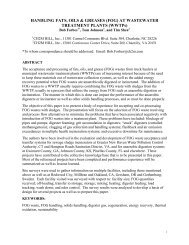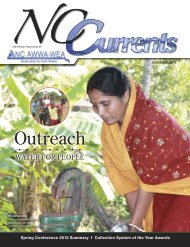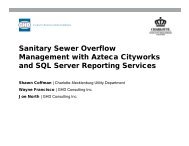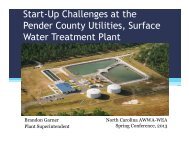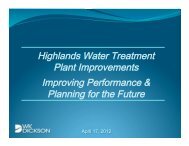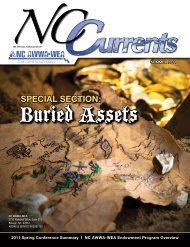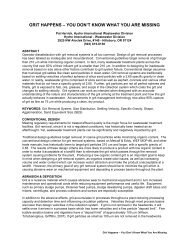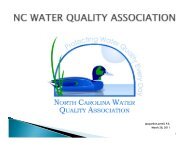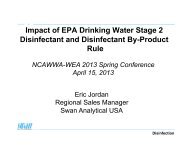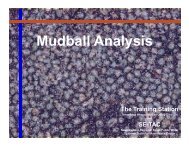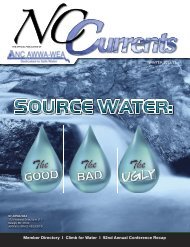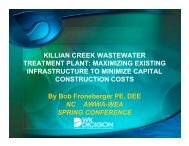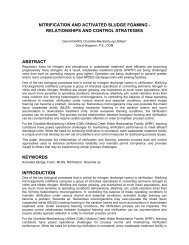TERTIARY CLOTH MEDIA FILTRATION WITHOUT ROTATING ...
TERTIARY CLOTH MEDIA FILTRATION WITHOUT ROTATING ...
TERTIARY CLOTH MEDIA FILTRATION WITHOUT ROTATING ...
You also want an ePaper? Increase the reach of your titles
YUMPU automatically turns print PDFs into web optimized ePapers that Google loves.
DiscussionFixed Plate Cloth Media - No Moving Parts – Reduced RedundancyFixed Plate cloth media filter systems offered several key advantages over existing rotating disk style clothmedia filter options. First, rectangular media elements stay fixed in place during all operations (no movingparts), eliminating much of the internal mechanical complexity, maintenance and cost associated with typicaldisk type cloth filter. Fixed filter plate systems use available differential head to produce forward andbackwash flow. Simple open-close pneumatic valves – operated by a small air compressor and simplecontrols - control the filtering and backwash operations and determine the direction of flow, eliminating theneed for pumps, manifolds, and rotating disks. Since elements do not rotate, they can be square orrectangular (vs. circular) easing manufacture, installation, removal, and maintenance. Element frames &tankage are 100% stainless steel, further reducing internal maintenance.Second, individual media elements can be isolated from the remainder of the incoming flow stream and removedfrom the system without disrupting flow to the remaining online elements (reduced redundancy). Multiple isolatedmedia panels within each tank or concrete basin allows incoming water to continue to enter the filter system whileindividual filter elements are being backwashed or are removed from the system. Incoming water is filtered throughremaining on-line filter elements with treated water continually replenishing the clean water reservoir or main tankarea. This liquid level is maintained while individual elements are gravity backwashed. Each element isbackwashed in sequence, allowing complete system backwash without discontinuing or diverting flow during theprocess. During the backwash, flow to only one element has to be discontinued. The filter at Bulverde hascapacity for six media elements, only 1/6 th of which would have to be off-line at any particular time, with theremaining 5/6 th or 83% of the media area remaining online. By sizing the unit to handle design flows with 5 of 6elements installed, one element can be removed from the flow stream without disruption to capacity, upstreamprocesses, or influent treatment.If periodic inspection of media is required, individual media elements can be isolated from the remaining elementsand removed from the filter system for periodic inspection and media replacement, all while flow continues toonline elements Internal components are modularized and integral to the media element (not attached to thetank), which allows all internal components for each element to be removed while flow continues to the otheronline filter elements. Elements can be removed, inspected and returned to service without decreasing systemcapacity or interrupting flow. All media within the system can be changed sequentially, while the remaininginstalled online elements treat the full design flow.The fixed plate filter systems incorporate an ‘inside-out’ flow pattern which is operationally advantageous to thosethat utilize ‘outside-in’ flow (where solids collect on the external areas of the media elements). Fluidyne’s fixedplate filter trap solids and biological material on the inside of the media elements, with cleaned effluent occupyingthe majority of the main tankage volume. This provides several benefits including allowing the operator to readilysee the quality of the effluent, cleaner operation, and reduced operator contact with collected biological solids.Also, since heavier solids settle to the bottom of the filter (which are then removed without additional equipment orpumps during the normal backwash stage), heavy solids never contact the cloth media or need to be ‘handled’.This eliminates the need for hopper bottoms or sludge collection manifolds at the bottom of the main tank.Also, some ‘outside-in’ systems utilize mechanical spray bars for cleaning, which spray high pressure water fromthe outside into the filter media, forcing some solids through the cloth to the clean water or interior side of the cloth,contaminating the effluent. In these systems, a separate 'rinse' cycle is then required where filtered water isdiverted for several minutes after a spray cycle. High pressure spray also damages the cloth media over time,enlarging the filter media openings and causing premature failure and replacement.Finally, since the fixed plate filter systems use simple open-close pneumatic valves and compressed airto provide both fluid flow control and agitation of the media during the air scour assisted backwash, noother mechanical systems are necessary. This significantly limits the power input to the system (a smallPLC to operate solenoids and a small 1-2 hp compressor which only runs during periodic backwashcycles) as well as mechanical wear items & required spare parts.Tertiary Cloth Media Filtration without Rotating discs, vacuum pumps or spray bars




